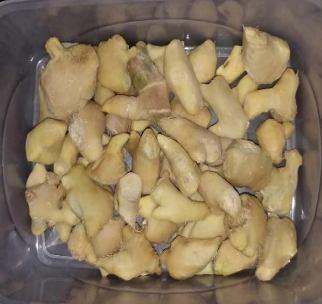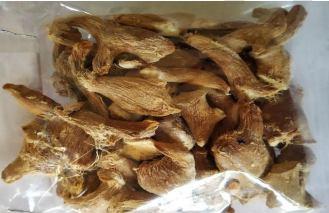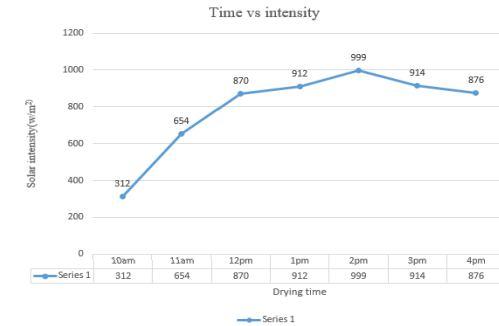
ISSN: 2321-9653; IC Value: 45.98; SJ Impact Factor: 7.538 Volume 11 Issue I Jan 2023- Available at www.ijraset.com


ISSN: 2321-9653; IC Value: 45.98; SJ Impact Factor: 7.538 Volume 11 Issue I Jan 2023- Available at www.ijraset.com
R. Mani1, S. Hariharan2, M. Gowtham3, P. Srinivasan4, P. Manikandan5, N. Harish6, G. Balasubramanian7
1Principal &Head of the Department of Mechanical Engineering, Muthayammal Polytechnic institution, Rasipuram, Namakkal 2, 4, 5Assistant Professor, 6,7 Under Graduate Student, Department of Mechanical Engineering, VSB College of Engineering Technical Campus.
3Assistant Professor SNS College of Technology, Coimbatore

Abstract: Along with water and air, grub is a basic requirement for all living things. The grub issue occurs in the majority of developing countries, primarily as a result of unpreserved food. As a result, the solar drying system makes use of the solar energy is used to heat the air and dry any agricultural produce that is loaded, thereby lowering the cost. Agriculture reduces food waste while also preserving it. And dried produce (Ginger) is easily transported. And promotes the health and well-being of all living things. There are a lot of agricultural lands in India. Because of various factors Due to climate change, many agricultural products are thrown away. To reduce such waste, solar dryers are used to dry agricultural produce. Wood, glass, net, pipes, anemometer, blower, and basic carpentry work are used to build the solar dryer and drying chamber. The fabrication of dryer and drying chamber is construct with basic carpentry work. The blower forced the air inside the heater area the air will be heated with the solar radiation and the heat air forced with the drying chamber. The drying chamber has a surface area of (40*40) cm. The ginger (1/2 kg) drying three specific periods of time, and the reading will notice with specific time. After the moisture content will removed to compare the produces life with open sun drying and solar drying method.
Keywords: Solar Air Collector, Drying Chamber, Ginger, Moisture Content, Drying Models, Efficiency of dryer.
One of the most common methods for preserving agricultural products is solar drying. In comparison to the solar drying system, the open sun drying system encountered a number of issues. The open sun drying system has issues with unprotected rain, wind-borne dirt and dust, infestation, insects and animals, and so on. As a result, the solar drying system was used to protect the agro product from the aforementioned issues. In comparison to open drying systems, solar drying systems will be much more effective and useful. Because the solar drying system will be simple to build, less money will be spent on dryer construction. The primary function of a dryer is to remove water in order to prevent microorganisms from growing. The three basic drying methods are I naturally drying, (ii) hot air drying, and (iii) freeze drying. The dryer constructs a second method for hot air here. The collector glass absorbs radiation after the hot air is forced inside the dryer using the method described above. And hot air will be forced to circulate through the drying chamber. The main issue for the process is heat loss, so heat loss energy will be calculated based on daily average radiation. The main goal of this paper is to reduce heat loss from the dryer and improve dryer performance. In this solar drying system we take the agricultural produce is ginger. The initial moisture content of the ginger is 85% constant. And the final moisture content is 15%. India, the largest producers of ginger, has an annual ginger production of around 385 thousand tonnes, according to Ministry of Agriculture. The ginger plant is a popular kitchen plant in every household in India. It belongs to the genus (Zingier officinal).The fruit amassed can be used directly for the day to day household cooking endeavours or can be dried to reduce moisture content to less than 10% and then, exported. The primary target for drying is the reduction of moisture content. Materials with high moisture content can lead to various adverse concerns when stored for later use like bacteria, dust, pets and viruses. Drying also makes it easier to wrap up, store and ship the materials has to be maintained at the least for the best results. The southern states of India stretched out close to the equator and is blessed through the year with a sunny and relatively dry climate especially, Tamil Nadu and hence it is suitable for the use of solar energy reduces the capital investment for any industry set up and it is non-polluting, renewable and infinite.
The most common method for the types are of cabinet form or wooden boxes with glass or flat plate collector cover. The dryer design construct with, the greenhouse effect, because the hot air increased inside the solar drying chamber and the air is forced circulated to the drying trays and around the produce, remove the moisture content and exits through the air outlet.
ISSN: 2321-9653; IC Value: 45.98; SJ Impact Factor: 7.538 Volume 11 Issue I Jan 2023- Available at www.ijraset.com

The hot air medium is used to drying, it remove the moisture from the produce to the atmosphere under natural convection. The dryer system consist of major two components one is drying air heater and another one is drying chamber. The following material are used to construct the solar dryer: Wood- it is the major part of dryer because full system made up of with wood including heater and drying chamber. The wood material is very cheaper and easily available than metals. Glass or Flat plate collector- it is absorbed the radiation and allow the solar radiation inside the heater surface but withstand the flow of heat energy out of the system. Sheet metal (1mm thickness) - is tightly fixed with the wooden box sides to reduce the air loss and also absorb the heat. Net and wooden frames used to construct the drying layers no of required. Pins and gum and screws and adhesives.
The figure shows the full experimental model the solar system made up of with certain design parameters and locally available components the main components are blower, a solar collector, and a drying chamber. The fabrication is done as per design values and available material is in mechanical and welding workshop. The temperature is main consideration for dryer because each produces are drying with particular temperature. So in the project we need minimum temperature of 300 C and the maximum temperature is 600 C. We get 470 C temperature. The hot climate passive solar dryers, need air gap. In this drying system 5cm air gap is created. In this solar drying system the air heater was covered with 5mm thickness glass and 1mm sheet metal cover. Used to absorb the solar radiation. The glass or collector cover with area of the heater is 98×68 cm2 The Air heater is constructed with the dimensions of 98×68×33 cm2 .made with wood tightly closed for insulation. And the drying chamber is calculated with 40×40 cm2 with two layer made with net.
1) Angle of Tilt (β) of solar collector/ Air Heater. It state that the angle of tilt (β) of the solar collector should be β = 100 + lat ɸ (1) Were lat ɸ is the latitude of the collector location, the latitude of Coimbatore where the dryer was designed is latitude 11.350 N. Hence, the suitable value of β use for the collector: β = 100 + 11.350 = 21.350.
2) Insolation on the collector surface Area. A research obtained the value of insulation for Coimbatore i.e. average daily radiation H on horizontal surface as; H = 999W/m2 .
3) And average effective ratio of solar energy on tilted surface to that on the horizontal surface R as; R =1.34 Thus, insulation on the collector surface was obtained as IC= HT = HR =999×1.34 1338.66W/m2
3. Determination of Collector Area and Dimension. The mass flow rate of air Ma was determined by taking the average air speed Va = 0.2m/s. The air gap height was taken as 5cm = 0.05m and the width of the collection assumed to be 50cm = 0.5m. Thus, volumetric flow rate of air
V'a = Va × 0.05 × 0.6
V'a = 0.2 × 0.05 × 0.5 = 5 × 10-3m3/s
Thus mass flow rate of air Ma =vaρa Density of air ρa is taken as 1.28kg/m3 Ma = 5 × 10-3 × 1.28 = 6.4 × 10-3 kg/s Therefore, area of the collector AC AC = (6.4 × 10-3 × 1005 × 30)/ (0.5 × 1338.66) = 0.288m2
The length of the solar collector (L) was taken as; L = Ac/B = 0.288/0.6 = 0.0.46m Thus, the length of the solar collector was taken approximately as 1m. Therefore, collector area was taken as (1 × 0.6) = 0.6m2
4) Determination of the Base Insulator Thickness for the Collector. The rate of heat loss from air is equal to rate of heat conduction through the insulation. The following equation hold for the purpose of the design.
FmaCp (T0 – Ti) = Ka Ac(T0 – Ta )/tb K = 0.04Wm-1K-1 which is the approximate thermal conductivity for glass wool insulation. F = 10% = 0.1
T0 = 65ºC and Ti = Ta = 35ºC approximately ma = 6.4 × 10-3Kgs-1 Cp = 1005JKg-1K-1 and Ac = 0.288m2 tb =[0.04 ×0.288× (6030)]/[0.1×6.4×10- 3×1005×(60-30)] = 0.017910= 1.791cm.
ISSN: 2321-9653; IC Value: 45.98; SJ Impact Factor: 7.538 Volume 11 Issue I Jan 2023- Available at www.ijraset.com

For the design, the thickness of the insulator was taken as 7cm. The side of the collector was made of wood, the loss through the side of the collector was considered negligible.
5) Calculation of Heat Losses from the Solar Collector (Air Heater). Total energy transmitted and absorbed is given by IcAcτα = Qu + QL + Qs where Qs is the energy stored which is considered negligible therefore IcAcτα = Qu + QL Thus QL the heat energy losses QL = IcAcτα – Qu Since Qu = maCp (T0 – Ti) = maCp∆T QL = ULAc∆T then ULAc∆T = IcAcτα - maCp∆T UL = (IcAcτα - maCp∆T)/(Ac∆T) α was taken as 0.9 and τ = 0.86 Ta = 0.774 UL = (1338.66×0.288×0.774 - 6.4×10-3 ×1005×30)/(0.288×30) = (298 -192.96)/8.64 UL = 12.15W/m2 °C. Therefore, QL = 12.15 × 0.288 × 30 = 104 W This heat loss includes the heat loss through the insulation from the sides and the cover glass.

ISSN: 2321-9653; IC Value: 45.98; SJ Impact Factor: 7.538 Volume 11 Issue I Jan 2023- Available at www.ijraset.com

The experimental were conducted for four number of days weight, weight of ginger is measured hourly by using electronic weighing machine and is plotted against time also solar intensity was measured by using solar meter and plotted against time. After the moisture content will be remove with solar intensity with six hours per day with single batch.
Time (hr) Drying time in hr
Solar intensity(w/m2 ) Weight of ginger (g) 10 am 0 312 1000 11 am 1 654 1000 12 pm 2 870 1000 1 pm 3 912 991 2 pm 4 999 985 3 pm 5 914 980 4 pm 6 876 976
After the result the basic calculations will be calculated with the moisture content with initial and final moisture content.
Fig 3: After drying


The solar dryer was made up of locally available material. So simple materials like wood, glass, pipe, etc. In this is solar drying very useful for formers to dry and prevent the agricultural produces. Compared to open drying method the solar drying method is very efficient because the performance will high compare to open dry method. The graph was explained with the amount of weight reduced particular time with solar intensity. The graph explain with the intensity will gradually increase at the same time the amount of water will be removed with the ginger. So the solar drying system is very useful for drying purpose for the all agricultural products.
ISSN: 2321-9653; IC Value: 45.98; SJ Impact Factor: 7.538 Volume 11 Issue I Jan 2023- Available at www.ijraset.com
[1] Karthikeyan, R., Kumar, R.A., Manikandan, P. and Senthilnathan, A.K., 2021. Investigation of solar air heater with phase change materials using packed bed absorber plate. Materials Today: Proceedings, 45, pp.1360-1365. https://doi.org/10.1016/j.matpr.2020.06.236
[2] Karthik, R., Mani, R. and Manikandan, P., 2021. Tribological studies of Ni-SiC and Ni-Al2O3 composite coatings by Pulsed Electrodeposition. Materials Today: Proceedings, 37, pp.701-706. https://doi.org/10.1016/j.matpr.2020.05.717
[3] Mani, R., Manikandan, P., Harish, N. and Subramanian, G.B., Tribological Studies of Pin Fin type Forced Convection Solar Air Dryer with Help of PCM as a Thermal Storage Medium. Volume, 10, pp.500-504. https://doi.org/10.22214/ijraset.2022.47024
[4] Srinivasan, P., Hariharan, S., Manikandan, P., NaveenKumar, S., Harish, N. and Balasubramanian, G., 2022. Tribological Studies of Shrinkage Defect and Effective Yield Upgrade of Grey Cast-Iron Castings. https://doi.org/10.22214/ijraset.2022.47196
[5] Hariharan, S., Manikandan, P., Srinivasan, P. and Kannarasu, V., Design and Implement a Semi-Automatic Clutch System for Automobiles Using DCV and the Link Mechanism to Reduce Human Effort While Increasing Process Reliability and Accuracy. https://doi.org/10.22214/ijraset.2022.47526
[6] Nallusamy, S., Narayanan, M.R. and Hariharan, S., 2017. SYNTHESIS AND CHARACTERIZATION OF TiN, TiAlN AND TiAlN/Si3N4 CHEMICAL NANOCOMPOSITE. http://dx.doi.org/10.7324/RJC.2017.1041909
[7] Mani R, Hariharan S, Srinivasan P, EdisonThangaraj J, Arunkrishnan M, Bala Subramanian G, Harish N."Investigation of Mechanical Characteristic of Al2O3 and Silicon Carbide Microparticles Reinforced with Aluminum LM6", Volume 10, Issue XI, International Journal for Research in Applied Science and Engineering Technology (IJRASET) Page No: 1627-1631, ISSN : 2321-9653, https://doi.org/10.22214/ijraset.2022.47679

